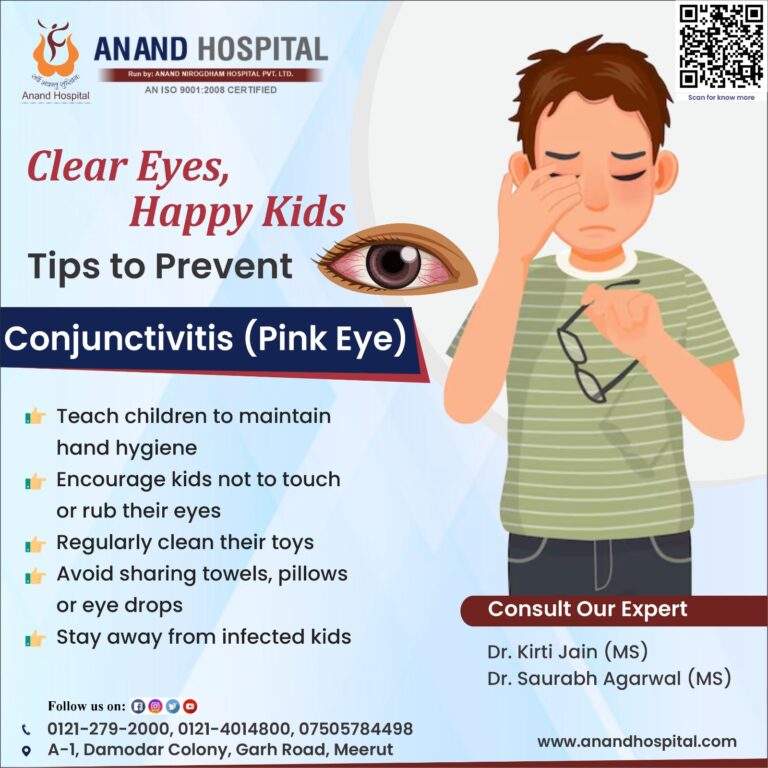Conjunctivitis, commonly known as “pink eye”, is a prevalent eye condition that affects children frequently. Recognized by the red or pink appearance of the eye, conjunctivitis can be uncomfortable and disruptive. Understanding this condition is essential for effective management and prevention, as conjunctivitis in children is highly contagious and can spread rapidly in environments like schools and daycare centers.
Anand Hospital Meerut offers comprehensive treatment options and resources for managing eye health in children.
What is Conjunctivitis?
Conjunctivitis is an inflammation of the conjunctiva, the thin, transparent tissue covering the white part of the eye and lining the inside of the eyelid. This inflammation causes blood vessels to become more visible, leading to the pink or red appearance. There are three main types of conjunctivitis in children: viral, bacterial, and allergic. Each type has distinct causes, symptoms, and treatment options.
Symptoms of Conjunctivitis in Children
The symptoms of conjunctivitis can vary depending on the type and cause, but common signs to watch for include:
- Red or Pink Eyes: The whites of the eyes turn pink or red, which is the most notable symptom.
- Watery or Thick Discharge: Viral conjunctivitis usually causes watery discharge, while bacterial conjunctivitis often leads to a thicker, yellow or green discharge.
- Itchiness or Irritation: Children may frequently rub their eyes due to itching or irritation.
- Swollen Eyelids: The eyelids may become puffy or swollen, especially in the case of allergic conjunctivitis.
- Sensitivity to Light: In some cases, children may feel uncomfortable in bright light.
- Crusting Around the Eyes: After sleep, there may be a crusty buildup around the eyelids, particularly with bacterial conjunctivitis.
If your child displays any of these symptoms, it’s essential to consult a healthcare provider for a proper diagnosis and treatment plan, especially if the symptoms worsen or last longer than expected.
Causes of Conjunctivitis in Children
Viral Infections: Viral conjunctivitis is often caused by the same viruses responsible for the common cold. This type of conjunctivitis is highly contagious and spreads through coughing, sneezing, or touching contaminated surfaces.
Bacterial Infections: Bacteria such as Staphylococcus or Streptococcus can lead to bacterial conjunctivitis. This type also spreads easily, especially through close contact, shared items, or touching the eyes with unwashed hands.
Allergens: Allergic conjunctivitis occurs when the eyes react to allergens such as pollen, pet dander, or dust. Unlike viral and bacterial conjunctivitis, allergic conjunctivitis is not contagious.
Environmental Irritants: Smoke, chlorine in swimming pools, or pollution can also irritate the eyes, leading to conjunctivitis. This type, known as chemical or irritant conjunctivitis, isn’t contagious but requires protection from further exposure to the irritant.

Treatment Options for Conjunctivitis in Children
The treatment for conjunctivitis in children depends on the type and severity. Here are some common approaches:
Viral Conjunctivitis: Viral conjunctivitis typically resolves on its own within a week or two. Treatment usually focuses on symptom relief. Applying a warm, damp cloth to the eyes can soothe irritation, and over-the-counter artificial tears can provide moisture. Ensuring your child avoids rubbing their eyes will also help prevent further discomfort and limit the spread of the virus.
Bacterial Conjunctivitis: Antibiotic eye drops or ointments are commonly prescribed for bacterial conjunctivitis. It’s essential to follow the treatment as prescribed to fully clear the infection, usually within a few days. Cleaning any discharge from the eye and maintaining good hand hygiene are also vital steps to prevent spreading the infection.
Allergic Conjunctivitis: For allergic conjunctivitis, avoiding known allergens is the primary preventive measure. In some cases, an antihistamine eye drop or oral medication may be recommended to reduce symptoms. A cold compress can help reduce swelling and irritation as well.
Irritant Conjunctivitis: In cases of chemical or irritant conjunctivitis, rinsing the eyes with clean water is essential to remove any remaining irritants. In severe cases, an eye specialist may suggest specific treatments.
Preventing Conjunctivitis in Children
Prevention is key to controlling the spread of conjunctivitis. Here are some simple yet effective preventive steps:
- Hand Hygiene: Encourage children to wash their hands regularly with soap and avoid touching their eyes.
- Avoid Sharing Personal Items: Items such as towels, pillows, or makeup should not be shared, especially if someone has an eye infection.
- Stay Home if Infected: Keeping children at home until their symptoms improve can prevent spreading the infection to others.
- Disinfect Surfaces and Toys: Frequently touched items and surfaces, especially in shared environments, should be cleaned to reduce the spread of infection.
- Teach Children Proper Sneezing and Coughing Etiquette: Sneezing or coughing into tissues or elbows can help prevent airborne spread of viral infections.
When to See a Doctor
While conjunctivitis often resolves on its own, there are situations where medical attention is necessary. Seek medical advice if:
- The symptoms worsen or do not improve within a few days.
- The child has severe pain or a high fever.
- There is sensitivity to light or vision problems.
- The affected eye becomes extremely swollen or red.
Conjunctivitis in children can be uncomfortable and concerning for parents, but with early recognition and the right care, most cases resolve without complications. Practicing good hygiene and taking preventive measures can make a big difference in keeping children’s eyes healthy and infection-free.
FAQs:
Common signs of conjunctivitis in children include red or pink eyes, itchiness, watery or thick discharge, swollen eyelids, and light sensitivity. If you notice these symptoms, consult a healthcare provider for a proper diagnosis.
Yes, both viral and bacterial conjunctivitis are highly contagious and can spread through direct contact, shared items, or respiratory droplets. Allergic and irritant conjunctivitis are not contagious.
Treatment depends on the type. Viral conjunctivitis often resolves on its own, while bacterial cases may require antibiotic drops. Allergic conjunctivitis may be treated with antihistamines, and irritant cases require flushing the eye to remove the irritant.

